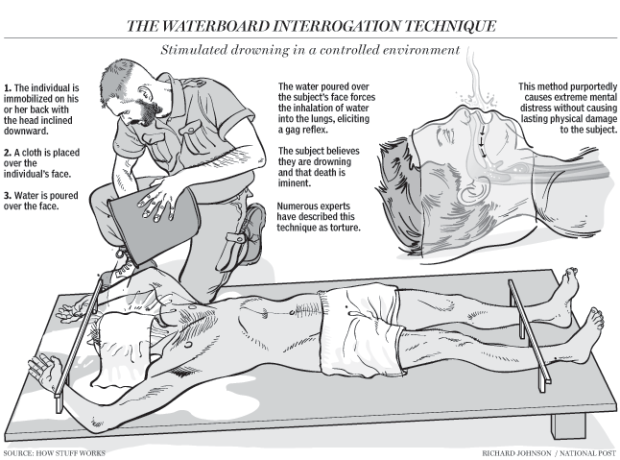Torture performed by the U.S. government in the aftermath of 9/11 has gotten more Americans killed than those Al-Qaeda attacks did. False information from waterboarding and renditions brought forth “evidence” that led to the invasion of Iraq, which killed 4,500 American soldiers and who knows how many Iraqis. Despite the numbers, some still cling to their belief in these brutal methods.
In the New York Review of Books, Hugh Eakin interviews journalist Mark Danner, who’s been reporting on America turning to torture since the Towers fell, about the recent Senate-report findings. The opening:
Hugh Eakin:
Nearly six years ago, you published the secret report by the International Committee of the Red Cross documenting the CIA’s torture of more than a dozen ‘high value’ detainees. And now we have the Senate’s extensive investigation of the torture program itself. What are some of the most revealing findings of the Senate report?
Mark Danner:
There is a lot in the executive summary that we already knew but that is now told in appalling detail that we hadn’t seen before. The relentlessness, day in day out, of these techniques; the totality of their effect when taken together—walling, close-confinement, water-dousing, waterboarding, the newly revealed ‘rectal rehydration,’ and various other disgusting and depraved things—is recounted in numbing, revolting detail. The effect can only be conveyed by a full reading, through page after awful page of this five-hundred-page document, which is after all less than 10 percent of the report itself.
What I think is strictly speaking new is, first, how amateurish the torture program was. It was really amateur hour, beginning with the techniques themselves, which were devised and run by a couple of retired Air Force psychologists who were hired by the CIA and put in charge though they had never conducted an interrogation before. They had no expertise in terrorism or counterterrorism, had never interrogated al-Qaeda members or anyone else for that matter. When it came to actually working with detained terrorists and suspected terrorists they were essentially without any relevant experience. Eventually, the CIA paid them more than $80 million.
The second great revelation is the degree to which the CIA claimed great results, and did so mendaciously. Sometimes the attacks they said they had prevented were not serious in the first place. Sometimes the information that actually might have led to averting attacks came not from the enhanced interrogation techniques but from other traditional forms of interrogation or other information entirely. But what the report methodically demonstrates is that the claims about having obtained essential, life-saving intelligence thanks to these techniques that had been repeated for years and years and years are simply not true. And the case is devastating.
Hugh Eakin:
This was a central question the Senate investigation was looking at, wasn’t it? The issue of whether actual intelligence was gained from torture. In essence, ‘Was it worth it?’
Mark Danner:
From the beginning the CIA had claimed that these techniques were absolutely essential to saving the lives of tens of thousands, or even hundreds of thousands of people. Those claims have been made by many people and it is another revelation of the report that we see CIA people, notably the lawyers, raising these claims before the program even existed. The lawyers seemed to be thinking, ‘This is the only way we’re going to get away with this.’ There is a quote in the report that people would look more kindly on torture—that is the word used—if it was used to stop imminent attacks. This was the so-called ‘necessity defense,’ which, as the CIA lawyers put it, could be invoked to protect from prosecution ‘US officials who tortured to obtain information that saved many lives.’ This idea was there right from the inception of the program.•

